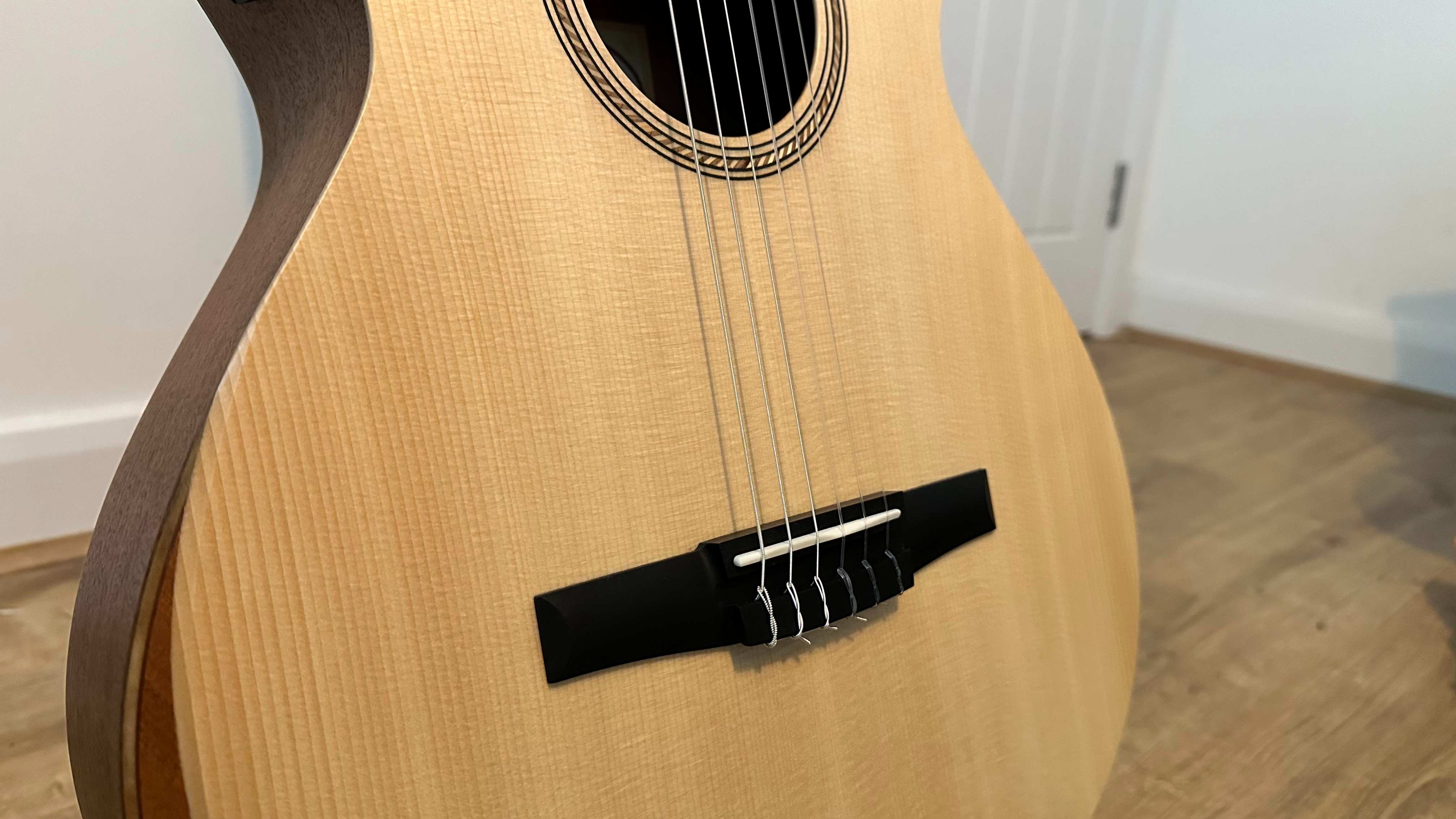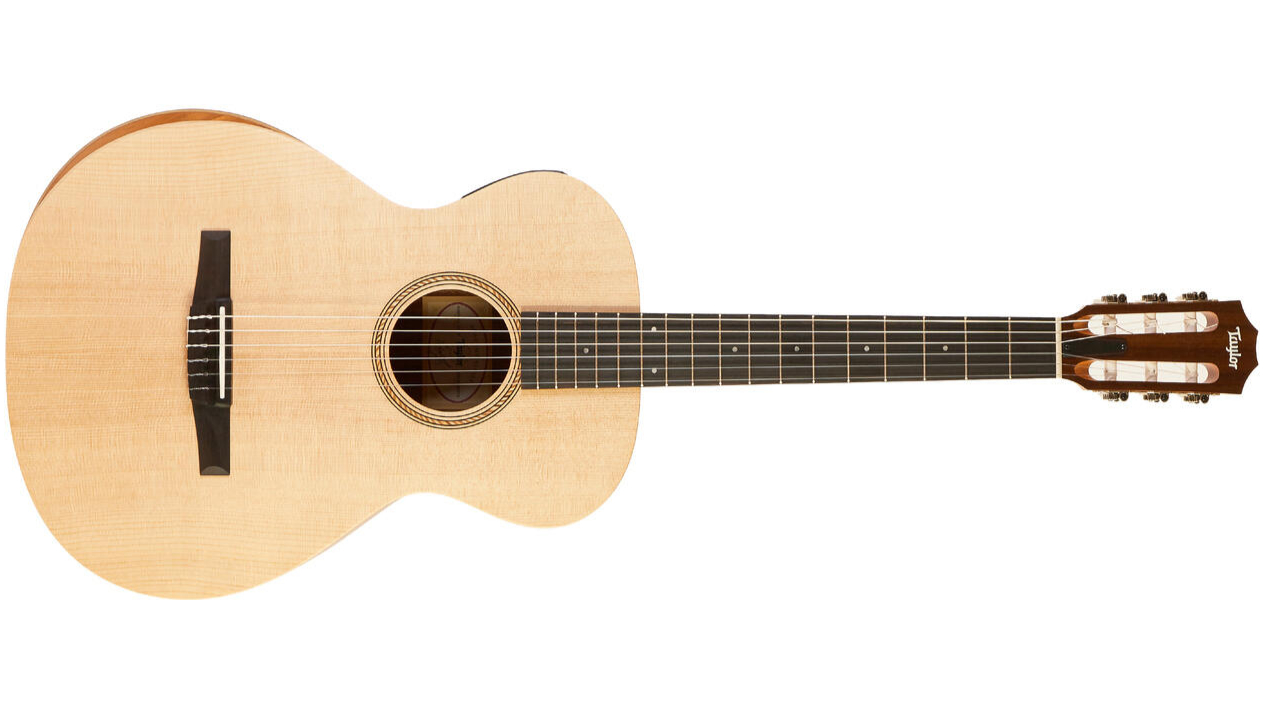
As many players will attest, particularly those who’ve graduated onto more svelte, lithe instruments, beginner classical guitars occasionally get a bad rap. You probably have your own story, and it possibly includes a cheap nylon-strung guitar with flaky paint and an action high enough to cut cheese. Thankfully, you can banish those memories to the past because a proper classical guitar is a wondrous thing and, in the Taylor Academy 12e-N, we have one such example to talk about here.
The 12e-N is not what you’d call an extravagant guitar by any means - but nor is it meant to be. As part of Taylor’s Academy range, the 12e-N is aimed squarely at beginners and anyone learning their craft. The Grand Concert body shape is ideal for this model; small enough for younger players, and when combined with the slightly narrower neck it’s also great for electric guitar players looking to dabble in a bit of flamenco on the side.
Visually, it sits on the right side of no-frills. The wood grain on the Sapele back and sides is visible and has a nice satin sheen to it, while the contrast between that and the spruce top is attractive. It doesn’t look like a cheap guitar, that’s for sure. There is even room for some mildly ornate features and decoration; there’s nice detailing around the soundhole, for example, and the nickel plate housing the tuning cogs adds a bit of visual flair.

The Taylor 12e-N has a slightly narrower neck than other classical guitars I’ve tried. As a (mostly) electric player, I wasn’t perturbed by this but pure classical players may find things a touch cramped. We’re talking fine margins here, but worth noting all the same.
Experienced classical players will also likely note the 20” radius on the fretboard which isn’t in the realm of a typical electric radius but will be noticeable if you’re used to completely flat fretboards. Again, I didn’t find this a problem but if you’re expecting something more traditional, then it might be worth testing the guitar out before you dip.
Tonally, the 12e-N is quite understated when played acoustically.
I found the 12e-N to be extremely lightweight and, therefore, easy to play for extended periods. The combination of the spruce top and layered sapele back and sides means there’s very little heft to the guitar and, as nylon strings generate less tension than steel, the 12e-N can get away with lighter bracing and, therefore, a reduced weight profile without sacrificing rigidity.
All of which means a beautifully light, structurally sound guitar that sustains nicely and can survive the odd ding without crumbling. Special mention, too, for the truss rod, which is not commonly found on guitars of this type but means it can be tweaked to your liking when you have it set up.
Tonally, the 12e-N is quite understated when played acoustically. If you’re expecting the same chime and resonance that you’d get from a steel-strung acoustic, then you need to dial back your expectations a touch. The sound is perfectly bright and balanced, but the combination of nylon strings and a smaller body means it’s not going to bowl anybody over in the volume stakes. Great news, then, that the 12e-N has an onboard pickup which sits underneath the saddle, and allows you to plug in via the jack/strap button on the bottom of the guitar.
An onboard interface allows you to tweak the guitar’s volume, while a 3-band EQ means you can adjust the sound to your liking. There’s even a tuner, which is particularly useful when you consider nylon strings can take a while to ‘bed in’ at first.
Conclusion

The Taylor 12e-N made a great impression on me. It evidently isn’t intended as a guitar to be hung on a wall and marvelled at, and nor does it pretend to be. The Taylor Academy 12e-N is a workhorse guitar designed to be picked up, put down, and generally handled by players of all abilities.
If you’re an experienced classical guitar player, then there might be some facets of the guitar that will put you off though; the slight fretboard radius and narrow neck aren’t traditionally found on nylon strung guitars, but that’s not to say they pose a problem. More a question of personal preference. Plus, if you’re an experienced classical player, then this guitar isn’t really aimed at you.
For the money, there is some serious competition. Established classical guitar brands like Alvarez and Cordoba have some credible options in that price bracket, while Takamine and Yamaha are also prominent.
That said, it’s hard not to fall for this Taylor’s understated charms. Yes, it’s expensive for a beginner acoustic guitar, but if you’re serious about learning and want the ideal platform on which to start your journey, then it’s an easy recommendation to make.
Specifications

- String Type: Nylon
- Number of Strings: 6
- Body Shape: Dreadnought
- Back & Sides Wood: Layered Sapele
- Top Wood: Lutz Spruce
- Finish: Satin Varnish
- Binding: Black
- Neck Wood: Mahogany
- Radius: 15"
- Fingerboard Material: West African Ebony
- Number of Frets: 17
- Scale Length: 25.5"
- Electronics: ES-N
- Contact: Taylor







